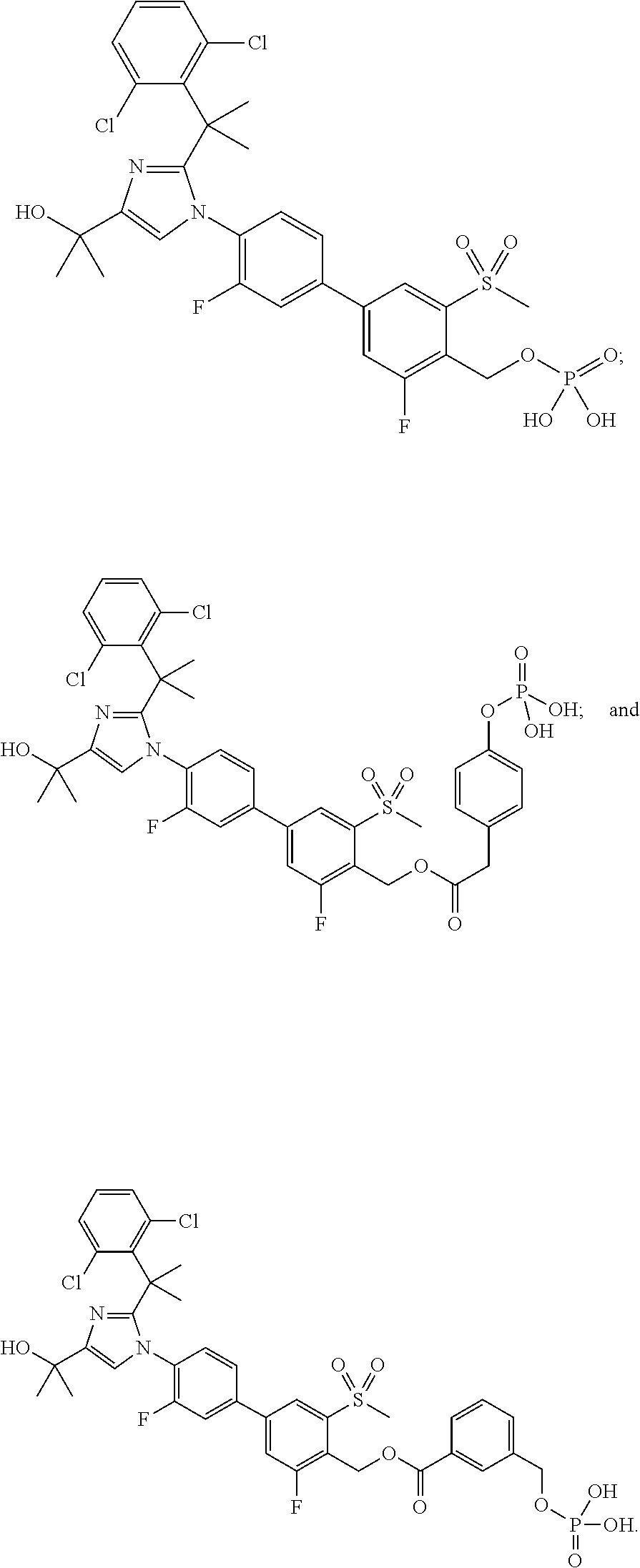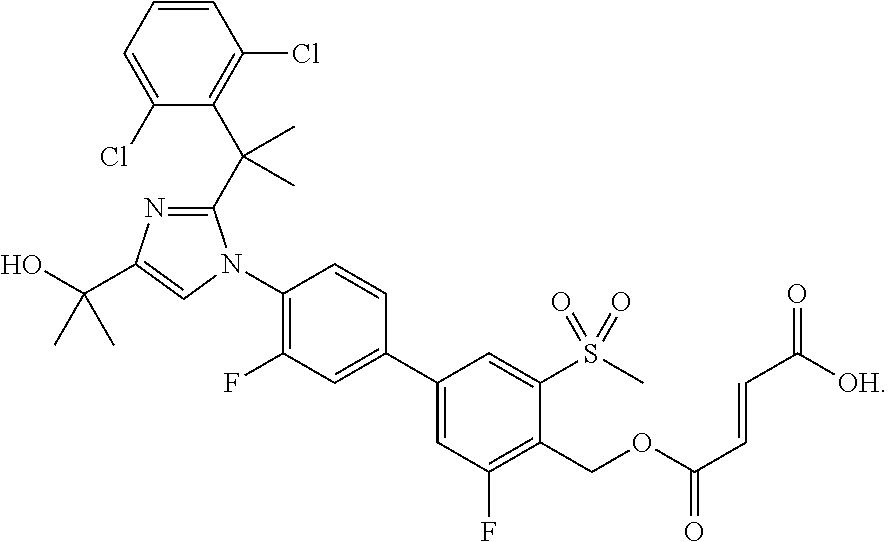Imidazole prodrug LXR modulators
- Summary
- Abstract
- Description
- Claims
- Application Information
AI Technical Summary
Benefits of technology
Problems solved by technology
Method used
Image
Examples
example 1
[0105]Di-tert-butyl (4′-(2-(2-(2,6-dichlorophenyl)propan-2-yl)-4-(2-hydroxypropan-2-yl)-1H-imidazol-1-yl)-3,3′-difluoro-5-(methylsulfonyl)biphenyl-4-yl)methyl phosphate (5.5 g, 6.9 mmol) was dissolved in toluene (94 mL) and then trifluoroacetic acid (5.18 mL, 10 equiv) was added. The reaction mixture was stirred at rt for 2.5 hours. After this time, analysis by LCMS indicated that the reaction was complete. Acetone (55 mL) and EtOH (5.5 mL) were added, and the resulting mixture was stirred for 2 hours. At the conclusion of this period, the resulting solid was collected by filtration to yield Example 1 (3.5 g) as white crystals. LCMS: (PHENOMENEX® Luna C18, 50×2 mm, 3 μm; Solvent A=5% MeCN: 95% H2O; Solvent B=95% MeCN: 5% H2O; gradient 1-100% B over 4 min.) retention time: 2.10 min; LCMS (APCI), m / z 687.4 (M−1). Example 1 (3.5 g) was further purified using preparatory HPLC (Waters Sunfire prep C18 OBD, 10 μm, 50×300 mm; Solvent A=100% H2O, 10 mmol NH4OAc; Solvent B=90% MeCN, 10% H2O,...
example 2
(4′-(2-(1-(2,6-Dichlorophenyl)-1-methylethyl)-4-(1-hydroxy-1-methylethyl)-1H-imidazol-1-yl)-3,3′-difluoro-5-(methylsulfonyl)biphenyl-4-yl)methyl dihydrogen phosphate diethyl amine salt
[0106]
[0107]To a solution of the purified Example 1 (5.0 g, 7.2 mmol) in acetone (20 mL) was added dropwise diethyl amine (1.83 mL, 18.1 mmol). The resulting mixture was stirred and hexanes were added. The resulting cloudy suspension was stored at ambient conditions for about 16 hours. After this time, the resulting white precipitate was collected by filtration and dried to yield Example 2 (2.7 g, 3.4 mmol, 47% yield, UV purity: 99.7%) as a white solid. Residual solvent analysis indicated the sample contained diethylamine (10.3% weight / weight), acetone (0.9% weight / weight), and dimethylformamide (0.03% weight / weight). 1H NMR (500 MHz, DMSO-d6) δ ppm 7.92 (1H, d, J=1.9 Hz), 7.89 (1H, dd, J=12.3, 2.0 Hz), 7.59 (1H, dd, J=11.2, 2.0 Hz), 7.31 (1H, dd, J=8.2, 1.9 Hz), 7.14 (2H, d, J=8.51 Hz), 7.12 (1H, d, J...
example 3
(4′-(2-(2-(2,6-Dichlorophenyl)propan-2-yl)-4-(2-hydroxypropan-2-yl)-1H-imidazol-1-yl)-3,3′-difluoro-5-(methylsulfonyl)biphenyl-4-yl)methyl dihydrogen phosphate with 2-amino-2-(hydroxymethyl)propane-1,3-diol and ethanol (di-(2-amino-2-(hydroxymethyl)propanediol) ethanolate salt)
[0108]
[0109]To a reactor was charged 2-(2-(2-(2,6-dichlorophenyl)propan-2-yl)-1-(3,3′-difluoro-4′-(hydroxymethyl)-5′-(methylsulfonyl)biphenyl-4-yl)-1H-imidazol-4-yl)propan-2-ol (prepared in the manner described in PCT Publication No. WO 2010 / 138598, 0.50 kg, 804 mmol) followed by acetonitrile (3.9 kg) and the resultant slurry was cooled to −10 to −15° C. Once at the prescribed temperature, diphosphoryl chloride (0.425 kg, 1.65 moles) was added over a period of ˜45 min. The resulting mixture was rinsed with acetonitrile and then stirred for one hour. After this time, the reaction was analyzed by HPLC, which indicated the reaction was complete. The reaction mixture was quenched by an inverse addition into a pre-...
PUM
| Property | Measurement | Unit |
|---|---|---|
| diffraction angles | aaaaa | aaaaa |
| diffraction angles | aaaaa | aaaaa |
| time | aaaaa | aaaaa |
Abstract
Description
Claims
Application Information
 Login to View More
Login to View More - R&D
- Intellectual Property
- Life Sciences
- Materials
- Tech Scout
- Unparalleled Data Quality
- Higher Quality Content
- 60% Fewer Hallucinations
Browse by: Latest US Patents, China's latest patents, Technical Efficacy Thesaurus, Application Domain, Technology Topic, Popular Technical Reports.
© 2025 PatSnap. All rights reserved.Legal|Privacy policy|Modern Slavery Act Transparency Statement|Sitemap|About US| Contact US: help@patsnap.com



